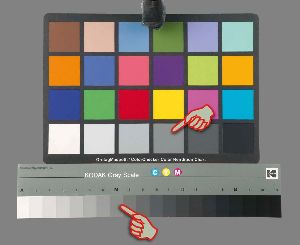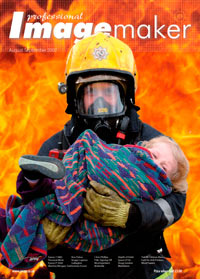articles/Lighting/lightingfordigital3-page2
Lighting for Digital 3 - part 2 of 1 2
by Dave Montizambert Published 01/08/2007

There is an easier way of setting mid-gray. Instead of a reflective light readings (which measures the amount of light radiating out of, or bouncing off a subject) we use a middle gray card, and take incident readings of the light striking the subject. To take these incident readings we need an incident meter. An incident meter is really just a modified reflective meter (see side-bar). Keep in mind that a light meter has a fraction of the brainpower of a worm; it has no idea what it is reading. All a meter does is measure the amount of electromagnetic radiation (light energy) striking its light-sensitive chip. Whether that energy comes from light bouncing off a gray card, a white wall, a scenic, or light coming directly out of a source like the sun, a light bulb, or a strobe-head (flash) it does not know, nor does it care. It would just as soon be snuggled up inside its soft felt-lined case, thinking about batteries, rather than pondering where the light striking it comes from.
It is important to remember, when taking an incident meter reading, that you don't point the meter at the subject. Instead you place the meter close to the subject plane and then point the white dome away from the subject to read the light that is striking. A reflective meter reads how much light is reflecting from a surface whereas an incident meter reads how much light is striking that surface. In addition to these essential tidbits of information, a reflective meter not an incident meter should be used to read directly off objects that give off light, such as a computer screen, an LED readout, hot steel, molten lava, a light-source such as a lamp that is to appear in your image. The reading displayed on your meter's readout is a setting to make that glowing source photograph as mid-gray, it is up to you what to set your camera at to make that glowing source look right; there is no correct exposure for such things. For instance, a glowing white window of an application on a computer screen might read f8 at 1/4 a second. This will render that white area as middle gray, but if you want that gray to look like a glowing white, then it is necessary to create a brighter exposure relative to this setting. In this example I would suggest setting exposure to somewhere between f8 at 1 to 2 seconds, now this screen window will be glowing white in the image.
By now you are probably just as sick of hearing the term middle grey as I am writing it. However, to a meter, middle grey is everything, that is its world, middle grey is all it knows or cares about (other than perhaps batteries). A meter can only be used for two things:
1. Find an exposure to make a mid-grey card photograph as middle grey whether that card exists in the final image or in the case of an incident meter reading, ever existed at all.
2. Make something that is not middle gray appear middle gray.
Be aware that either one of these readings will not tell you the actual brightness value of a given subject, for that we need to take an exposure reading (a reflective meter reading off a grey-card or an incident reading of the light striking) then take a subject brightness reading (a reflective meter reading directly off the subject in question), and then compare the second reading to the first. How much brighter or darker the subject brightness reading is relative to the exposure reading is the real life subject brightness. For instance, a reflective meter reading off a grey-card or an incident reading of the light striking Tony (see Image [1]) gave me an exposure reading of f8. A reflective reading off Tony's flesh in an area that was fully lit and glare-free reads f5.6. F5.6 is one stop darker or half the brightness of f8, therefore according to my meter Tony is half as bright as a grey-card (in real life he actually seemed quite intelligent). So on the gray-scale, Tony's flesh is a minus one value or a Zone 4.
The most advanced form of metering is spot metering. This allows you to selectively meter parts of a scene or subject with reflective readings. Exposure and contrast decisions from these readings rely on your ability to accurately recognize real-life tones and expose them accordingly for a correct exposure or expose them incorrectly for subjective reasons. To develop this skill you need to practice identifying tones. To do this look at the tone in question, ask your-self is it brighter, darker, or the same as middle grey? Then to check your accuracy, do the "two-reading two-step" described above. In a very short time you will become a tone recognition expert and the life of any party you attend as you show off your new highly developed skill.
Dave Montizambert lectures internationally on lighting, digital photography, and Adobe Photoshop. He is also a published author having written two books on lighting and digital photography (www.montizambert.com ) plus numerous magazine articles on these topics in North America, Europe, Russia and Asia. Dave also creates Photoshop tutorial CDs & DVDs for www.software-cinema. com. Dave is available for lectures and workshops in your area and can be reached at montizambert@telus.net or www.montizambert.com . Dave Montizambert owns and operates Montizambert Photography Inc. located in downtown Vancouver. For the past 25 years his company has created photographic images to aid various organisations and companies with their communication needs. He has created images for clients such as: McDonalds Foods, Motorola, Atlanta Scientific/Nexus Engineering, Toyo Tires, Tri-Star Pictures, Warner Brothers, Constantine Films of Germany, Chevron Canada, Cuervo Tequila, the Canadian Broadcasting Corporation, J&B Scotch, Hong Kong Bank, Chimera Softboxes, B.C. Lottery Corp., Blackcomb & Whistler Mountains, Tsing Tao Brewery of China, B.C. Hot House, Kona Bikes, No Fear Sports Gear, Kodak, and Canada Post. His work has won Georgie, Lotus, Hemlock, Studio Magazine, CAPIC, and Graphex awards.
Please Note:
There is more than one page for this Article.
You are currently on page 2 Contact Dave Montizambert
1st Published 01/08/2007
last update 09/12/2022 14:55:49
More Lighting Articles
There are 0 days to get ready for The Society of Photographers Convention and Trade Show at The Novotel London West, Hammersmith ...
which starts on Wednesday 15th January 2025





